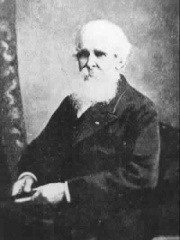
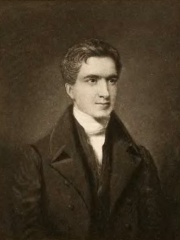
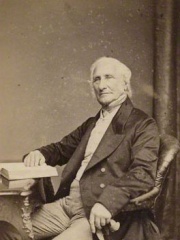
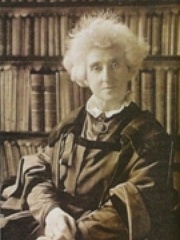
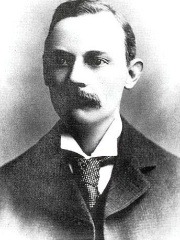
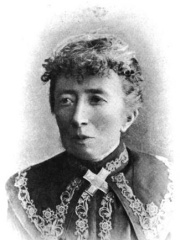
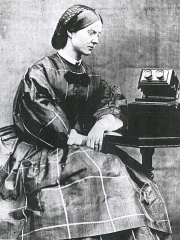
The Most Famous
ASTRONOMERS from Ireland
This page contains a list of the greatest Irish Astronomers. The pantheon dataset contains 644 Astronomers, 8 of which were born in Ireland. This makes Ireland the birth place of the 18th most number of Astronomers behind Sweden, and Ukraine.
Top 8
The following people are considered by Pantheon to be the most legendary Irish Astronomers of all time. This list of famous Irish Astronomers is sorted by HPI (Historical Popularity Index), a metric that aggregates information on a biography's online popularity.

1. Andrew Graham (1815 - 1908)
With an HPI of 63.27, Andrew Graham is the most famous Irish Astronomer. His biography has been translated into 26 different languages on wikipedia.
Andrew Graham (8 April 1815 – 5 November 1908) was an Irish astronomer, orbit computer and discoverer of the asteroid 9 Metis.

2. Thomas Romney Robinson (1792 - 1882)
With an HPI of 60.40, Thomas Romney Robinson is the 2nd most famous Irish Astronomer. His biography has been translated into 16 different languages.
John Thomas Romney Robinson (23 April 1792 – 28 February 1882), usually referred to as Thomas Romney Robinson, was an Irish astronomer. He was the director of the Armagh Observatory, one of the chief astronomical observatories in the UK of its time. He is remembered as inventor of the 4-cup anemometer.

3. Edward Sabine (1788 - 1883)
With an HPI of 59.76, Edward Sabine is the 3rd most famous Irish Astronomer. His biography has been translated into 27 different languages.
Sir Edward Sabine (; 14 October 1788 – 26 June 1883) was an Irish physicist, geodesist,astronomer, geophysicist, ornithologist, polar explorer, soldier, and the 30th president of the Royal Society. He led the effort to establish a system of magnetic observatories in various parts of British territory all over the globe. Much of his life was devoted to their direction and to analysing their observations. Other research focused on the birds of Greenland, ocean temperatures, the Gulf Stream, barometric measurement of heights, arc of the meridian, glacial transport of rocks, the volcanoes of the Hawaiian Islands and various points of meteorology.

4. Margaret Lindsay Huggins (1848 - 1915)
With an HPI of 57.66, Margaret Lindsay Huggins is the 4th most famous Irish Astronomer. Her biography has been translated into 25 different languages.
Margaret Lindsay, Lady Huggins (née Murray; 14 August 1848 – 24 March 1915) was an Irish-English scientific investigator and astronomer. With her husband William Huggins she was a pioneer in the field of spectroscopy and co-wrote the Atlas of Representative Stellar Spectra (1897).
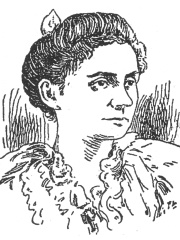
5. Mary Proctor (1862 - 1957)
With an HPI of 56.86, Mary Proctor is the 5th most famous Irish Astronomer. Her biography has been translated into 21 different languages.
Mary Proctor (1 April 1862 – 11 September 1957) was a British-American popularizer of astronomy. While not a professional astronomer, Proctor became well known for her books and articles written for the public – particularly her children's fiction.

6. Andrew Claude de la Cherois Crommelin (1865 - 1939)
With an HPI of 56.43, Andrew Claude de la Cherois Crommelin is the 6th most famous Irish Astronomer. His biography has been translated into 17 different languages.
Andrew Claude de la Cherois Crommelin (6 February 1865 – 20 September 1939) was an astronomer of French and Huguenot descent who was born in Cushendun, County Antrim, Ireland. He was educated in England at Marlborough College and Trinity College, Cambridge. After a spell teaching at Lancing College he found permanent employment at the Royal Greenwich Observatory in 1891. He joined the Royal Astronomical Society in 1888 and was its president from 1929-1931. In 1895 he joined the British Astronomical Association and was president from 1904-1906 and directed its comet section 1898-1901 and 1907-1938. In 1910 for their studies of Halley’s Comet Crommelin and Philip Herbert Cowell jointly received the Prix Jules Janssen from the Société astronomique de France. For this work they also received the Lindemann prize of the Astronomische Gesellschaft in Germany. In 1914 Crommelin published an introductory book on astronomy “The Star World”. Crommelin had four children, of whom two died in a climbing accident on Pillar Rock, Ennerdale, in 1933. The de la Cherois line was succeeded through Crommelin's daughter Andrina. The author May Crommelin was one of Andrew’s cousins. An expert on comets, his calculation of orbits of previously identified Comet Pons 1818 II, Comet Coggia-Winnecke 1873 VII, and Comet Forbes 1928 III in 1929, showed that these were one and the same periodic comet. It thus received the rather unwieldy name "Comet Pons-Coggia-Winnecke-Forbes". In 1948, he was posthumously honored when the comet was renamed after him alone (today, in modern nomenclature, it is designated 27P/Crommelin). This is similar to the case of Comet Encke, where the periodic comet is named after the person who determined the orbit rather than the possibly-multiple discoverers and re-discoverers at each apparition. In 1937 Crommelin and Mary Proctor jointly published a book entitled "Comets: Their Nature, Origin, and Place in the Science of Astronomy”. Crommelin took part in several solar eclipse expeditions including those of 1896, 1900 and 1905. In 1919 he went to Sobral, in Brazil, and measured the amount of deflection of light caused by the gravitational field of the Sun. The results from these observations were crucial in providing confirmation of the General Theory of Relativity, which Albert Einstein had proposed in 1916.

7. Agnes Mary Clerke (1842 - 1907)
With an HPI of 55.05, Agnes Mary Clerke is the 7th most famous Irish Astronomer. Her biography has been translated into 27 different languages.
Agnes Mary Clerke (10 February 1842 – 20 January 1907) was an Irish astronomer and writer. She was born in Skibbereen, County Cork, Ireland, and died in London.

8. Mary Ward (1827 - 1869)
With an HPI of 51.69, Mary Ward is the 8th most famous Irish Astronomer. Her biography has been translated into 23 different languages.
Mary Ward (née King; 27 April 1827 – 31 August 1869) was an Irish naturalist, astronomer, microscopist, author, and artist. She was killed when she fell under the wheels of an experimental steam car built by her cousins. As the event occurred in 1869, she is the first person known to have been killed by a motor vehicle.
People
Pantheon has 8 people classified as Irish astronomers born between 1788 and 1865. Of these 8, none of them are still alive today. The most famous deceased Irish astronomers include Andrew Graham, Thomas Romney Robinson, and Edward Sabine.
Deceased Irish Astronomers
Go to all RankingsAndrew Graham
1815 - 1908
HPI: 63.27
Thomas Romney Robinson
1792 - 1882
HPI: 60.40
Edward Sabine
1788 - 1883
HPI: 59.76
Margaret Lindsay Huggins
1848 - 1915
HPI: 57.66
Mary Proctor
1862 - 1957
HPI: 56.86
Andrew Claude de la Cherois Crommelin
1865 - 1939
HPI: 56.43
Agnes Mary Clerke
1842 - 1907
HPI: 55.05
Mary Ward
1827 - 1869
HPI: 51.69
Overlapping Lives
Which Astronomers were alive at the same time? This visualization shows the lifespans of the 8 most globally memorable Astronomers since 1700.

